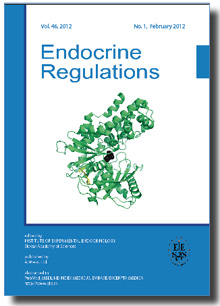Journal info
|
||
Select Journal
Journals
Bratislava Medical Journal Ekologia - Ecology Endocrine Regulations 2015 2014 2013 2012 2011 2010 2009 2008 2007 2006 2005 2004 2003 General Physiology and Biophysics Neoplasma Acta Virologica Studia Psychologica Cardiology Letters Psychológia a patopsych. dieťaťa Kovove Materialy-Metallic Materials Slovenská hudba 2025Webshop Cart
Your Cart is currently empty.
Info: Your browser does not accept cookies. To put products into your cart and purchase them you need to enable cookies.
Endocrine Regulations Vol.45, No.3, p.131-137, 2011 |
||
| Title: 7-hydroxylated derivatives of dehydroepiandrosterone as possibly related to menstrual mood change in healthy women | ||
| Author: M. Duskova, K. Simunkova, M. Hill, L. Starka | ||
| Abstract: Objective. Mood changes occur often in the luteal phase of menstrual cycle. Steroids modulating GABAA and NAMD receptors in the brain, namely allopregnanolone, were suggested as a factor of premenstrual syndrome. Another neurosteroid influencing the well-being is dehydroepiandrosterone. In the past decade it was shown by several authors that some dehydroepiandrosterone derivatives, especially those with 7-hydroxy- or 7-oxo group, exert a higher activity than dehydroepiandrosterone itself. It was also reasonable to see whether the levels of circulating 7-hydroxy-derivatives of dehydroepiandrosterone differ in the follicular and luteal phase of the menstrual cycle. Methods. Steroids known to exert neuroprotective effects, namely 7α- and 7β-hydroxy-dehydroepiandrosterone, 5-androstene-3β,7α,17β-triol and 5-androstene-3β,7β,17β-triol, were determined in midfollicular and midluteal phase of the menstrual cycle of 22 healthy women with a regular menstruation cycle. Results. Whereas the maternal steroids, dehydroepiandrosterone and androstene-3β,17β-diol showed no significant difference between the phases of menstrual cycle, the levels of their 7-hydroxylated metabolites were significantly lower in the luteal phase. Conclusion. It is suggested that the observed decrease of 7-hydroxylated metabolites during the luteal phase may be a factor related to the etiopathogenesis of mood change and neurocognitive disturbances, which are known to be more accented in that particular phase of the menstrual cycle. |
||
| Keywords: menstrual cycle, menstrual mood change, mealthy women, mehydroepiandrosterone, 7-hydroxydehydroepiandrosterone | ||
| Year: 2011, Volume: 45, Issue: 3 | Page From: 131, Page To: 137 | |
| doi:10.4149/endo_2011_03_131 |
||
|
Price:
14.00 €
|
||
|
|
||

